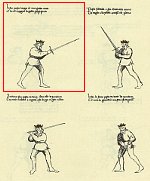| Fiore dei Liberi: Flos Duellatorum, 1410 (Pisani-Dossi, F. Novati, Bergamo, 1902) |
| 4 spada longa - longsword |
4.1.5 posta longa  , instabile1 (the long guard) , instabile1 (the long guard) |


Io son posta longa cum mia spada curta
Che cum ingegno la golla spresso furta |
I am the long guard with my short sword
That with cunning I stealthly despise the throat |
Synopsis: Fiore speaks of a "short" sword when it is clear that he is not using a short sword, but a longsword, and the reference to "stealth" suggests a degree of deception on the part of the master towards the zugadore. The first line of the couplet points out a long guard but describes it in the context of a shortended sword, perhaps implying by the orientation of the point towards the zugadore's head, the zugadore cannot truly see the true length of the sword and therefore, the sword is disguised in this manner. The second line describes a talent or skill or cunning whereby one can deploy the long guard to evade a parry and deliver a cut or thrust to the demise of the zugadore who was unsuccessful in parrying the long guard.
Application: The long guard is an extremely effective guard for the purpose of confusing or intimidating or deceiving the zugadore with the offensive point of the sword which is oriented towards the zugadore's face. The deception involved with this guard encompasses a pair of dimensions, the first deception is given the orientation of the sword, the wielder projects the image that the longsword is actually shorter than its true length. The second dimension is given the point work involved is evading parrying by the opponent whereby the wielder can then quickly return with a cut or thrust against the zugadore's throat. Distance may be compromised on the part of the zugadore when misinterpreting the guard and closing in on the wielder only to find himself/herself facing a thrust with a "longsword". In the second case, escaping the parrying or clearing aside by the opponent against the long guard can result in receiving a wound given the zugadore has just "spent" the parry and the long guard is able to reposte with a quick cut. Fiore describes the deployment of the long guard in terms of instabile meaning, the thrust or cut is deployed concurrently with a passing step. Care must be taken to not fully extend one's arms when deploying the long guard otherwise the wielder is "spent" and will unable to deploy a thrust or cut as described earlier.
Footnotes
- instabile in which to delivery a successful blow (thrust or cut), one must take a full step (a passing step). This info was derived from the Getty's version of Liberi's treatise.
 , instabile1 (the long guard)
, instabile1 (the long guard) , instabile1 (the long guard)
, instabile1 (the long guard)